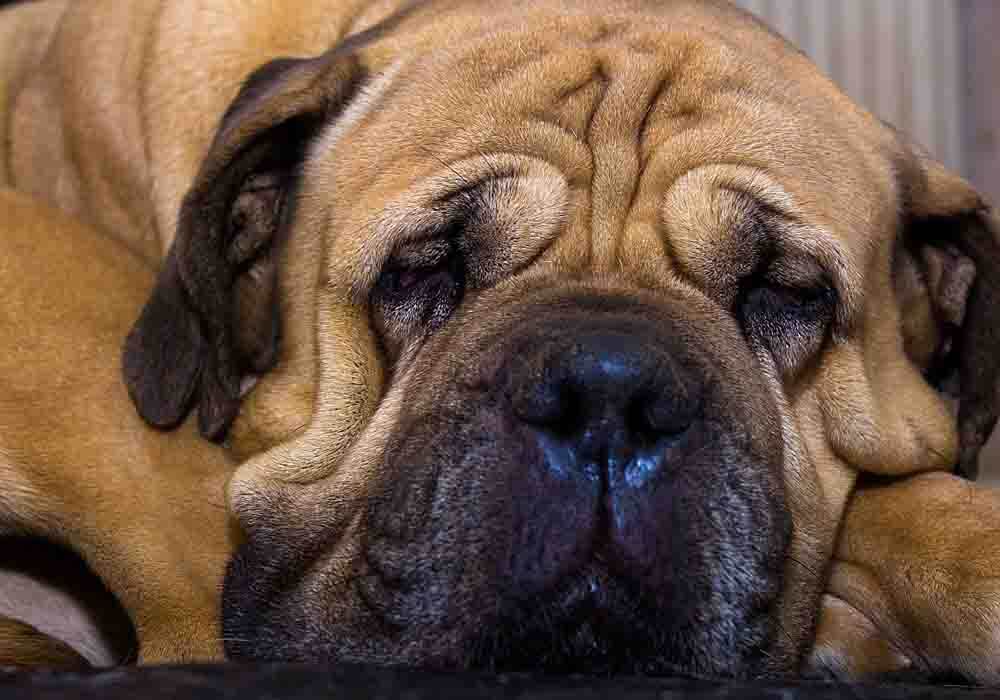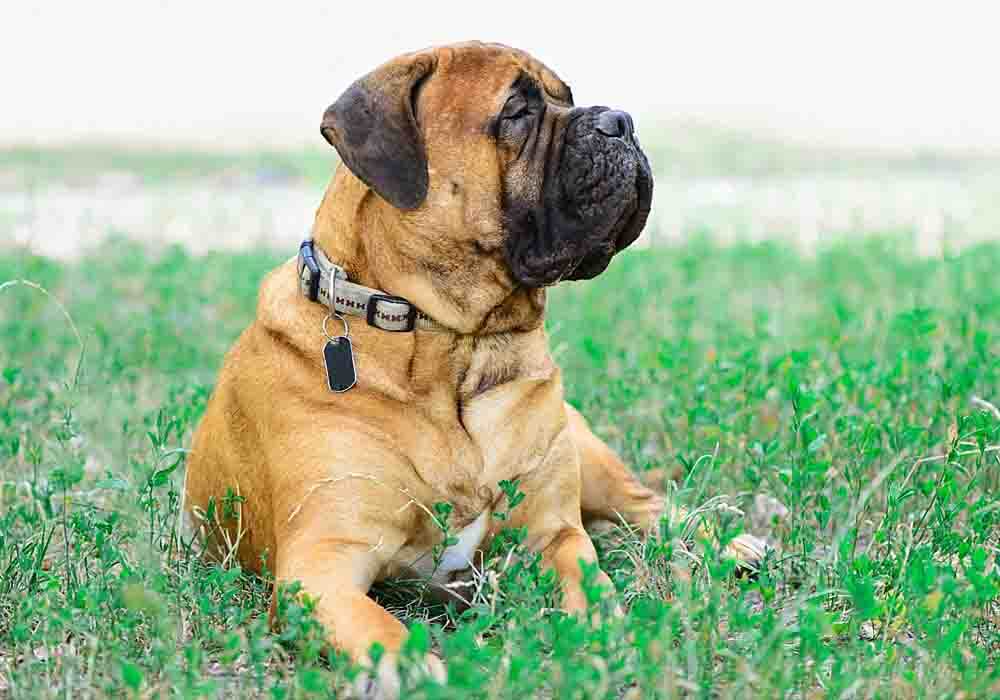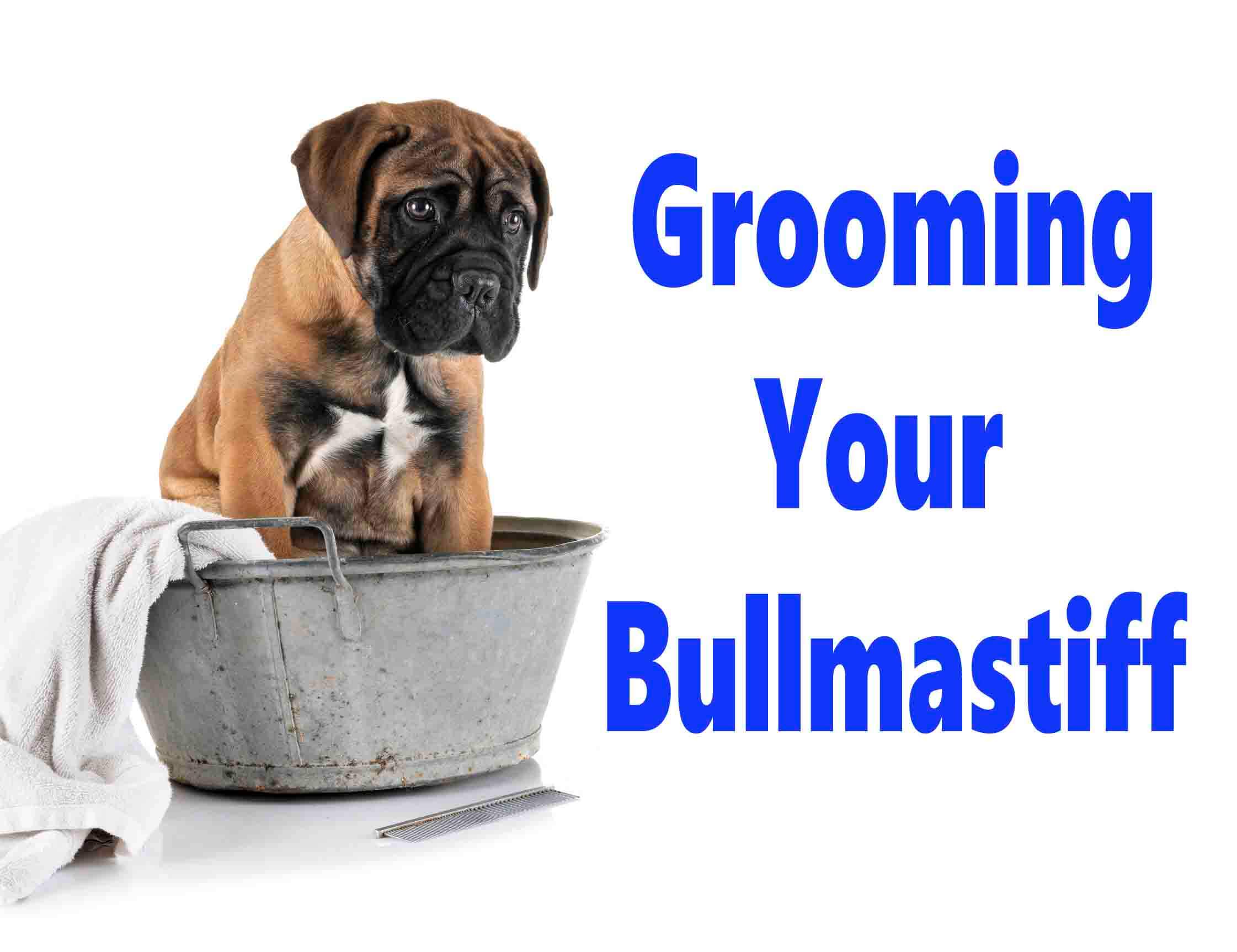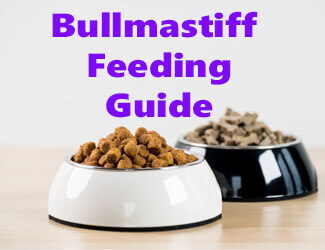Bullmastiff Heat or Cold Tolerance
Can They Handle Either?
by Ken Alden
Bullmastiffs are fearless and strong dogs loved for their loyalty and their willingness to please their owners. However, the lack of a heavy coat found on some dogs in its size range means that many people are unsure about what constitutes comfortable weather for the dog.
Bullmastiff Heat Or Cold Tolerance...
When it comes to hot or cold weather, Bullmastiffs have a moderate to high tolerance for the cold, but low tolerance to heat. Because of this they're at risk for heat stroke in temperatures above 106°F (40°C) due to its short muzzle.
The article will cover all you need to know about taking care of your Bullmastiff in both cold and hot weather environments. Read More Below...
Pro-tip: Ever try lifting a Bullmastiff? Their weight can hurt not only your back but their joints when they hop down from cars, sofas or even your bed. To protect your back and theirs check out the best Mastiff ramps on Amazon.com now.
What Are Bullmastiffs?
Bullmastiffs are a cross between the Mastiff and the Bulldog known for their short and dense coat and large-sized body. They are a modern breed that came into existence around 1860—first owned by English gamekeepers looking for a fearless dog that is large, quiet, and has the speed to chase down poachers and hold them down.
The cross between the Mastiff and the Bulldog was the one that met all the requirements. The Mastiff leg of the cross brought size and strength, while the Bulldog brought tenacity, speed, and bravery.
The England Kennel Club recognized the breed in 1924, and the American Kennel Club followed suit in 1933. The breed has since grown in popularity as a 2018 AKC ranking shows it is ranked 51st out of 192 recognized breeds.

Bullmastiffs in Cold Weather
Although Bullmastiffs have a short and dense coat, they have a relatively high tolerance for cold weather. They are regarded as cold-weather canines, as they can live comfortably in wintry climates.
This is not to say that you can leave them outside in subzero temperatures. A good way to know if the weather is too cold for your dog is to consider if you can stay comfortable outside in the weather with one layer of clothing and how long you’d last. If the weather is too cold for you, your Bullmastiff, with its short coat, will feel the same way.
Pro-tip: Bullmastiff anxiety, aggression, destructive chewing, jumping up, fearfulness, and other behaviors can be controlled with the right training program.
Here’s a great course that
addresses these issues along with many other dog training basics: Check it out now!
How to Take Care of Bullmastiffs in Freezing Weather
To keep your Bullmastiffs comfortable during the freezing winter, here are some points you should keep in mind:
Don’t Leave Them Outside
As the weather becomes uncomfortably cold, you should pay attention to where your dog spends its time resting or sleeping. Although your dog will probably be fine on its own outside, bringing your dog indoors is safer. This is especially true for puppies or senior Bullmastiffs. These groups shouldn’t be left outside without supervision in such weather.
If the dog has to stay outside, get it a proper doghouse. The house has to be large enough to contain the dog comfortably, but it can retain its body heat within the size. To ensure the house is warm, elevate the floor by a few inches to keep it off the ground. Don’t forget to protect the door with a heavy plastic flap to keep out the chilly wind.
Dress Them Up for the Weather
To keep your dog warm when you go out in very chilly weather, you should get a comfortable sweater or warm clothes for use when you are taking the dog out for a walk. You can make a sweater for your dog at home if you’ve got the DIY skills.
The sweater doesn’t need to be very thick to
avoid leaving the dog in discomfort when walking around for a while. If you’d
rather buy ready-made sweaters, Kuoser and BingPet are two brands you should look at.
Provide More Food and Water
A bullmastiff expends a lot of energy to keep itself warm in cold weather. Therefore, you should ensure it is properly fed so it will have the energy it needs to generate more body heat. You should consider increasing the rations for younger dogs.
Don’t forget to supply your dog with fresh, unfrozen water to stay hydrated. The dry winter can be very demanding on moisture levels in its body.
What to Do if Your Dog Is Exposed to Too Much Cold
If your dog has been inadvertently left in the cold for too long, the first thing you should do is to get it inside a warm room as quickly as possible. Check for signs of frostbite, and cover it with a blanket if there are none. If you notice signs of frostbite, on the other hand, you should get it to the vet as fast as possible.
Bullmastiffs in Hot Weather
As we’ve stated earlier, Bullmastiffs have a low tolerance for hot weather. Once the weather is as high as 106°F (40°C), there is a high chance that the dog will suffer heatstroke. However, this number is not set in stone. Some dogs begin to show signs of discomfort once the weather crosses beyond 86°F (30°C), and if ignored, heatstroke can happen if the weather gets hotter.
This is why you should pay attention to your dog when the temperature soars. The first sign that your dog is feeling uncomfortable in hot weather is heavy panting. You may also find it looking for concrete or tile floor to lie down.
How to Take Care of Bullmastiffs in Hot Weather
To take care of your Bullmastiffs in hot weather, here are some steps to follow:
Keep Them Away From the Sun
Once the weather is too hot, get your dog under a shade. If they are indoors, make sure the room is air-conditioned. By reducing direct exposure to sunlight, the dog will have a better shot at regulating its inner body temperature naturally.
Provide Fresh Water
Your dog will need a constant supply of drinking water once the weather is rising. Make a few drinking spots around the house and keep the water in the containers at tap temperature. Change the water after a while to maintain the temperature. By increasing the number of drinking spots around the house, your dog won’t have to walk too far to find water when it’s in need of it.
Limit Exercise
Just as you won’t feel good running around in hot weather, your Bullmastiff can overheat if you take it out for exercise when the weather is at its hottest. Limit all exercise during the hot months too early in the morning or late in the evenings.
Pro-tip: Bullmastiff's (and their owners) love dog crates…and for good reasons. Crates keep dogs from mischief while you're away, are perfect for house training, for traveling by car, and provide the dog a place to de-stress. Check out the best Mastiff crates on Amazon.com now.
What to Do if Your Bullmastiff Suffers Heat Stroke
If you adhere to the tips above, your dog's chances of suffering a heatstroke will be very minimal. If it happens, however, there are a few things you can do:
- Take it to a cooler place. If your dog overheated in a car or in a poorly ventilated room, take it to a properly ventilated or an air-conditioned room as fast as possible, so it will gradually calm down.
- Don’t give it ice cold water. It feels like the natural thing to do, but giving your dog ice cold water in this situation will only constrict the blood vessels and make it harder for the dog’s cores to cool down. Spray only tap-cold water on its face, armpits, and mouth. Also, don’t let it drink water at this point to avoid bloating.
- Apply alcohol to the pads on their feet. Alcohol evaporates faster, so it can help the dog calm down a lot faster than water.
- Take it to a vet. If your dog collapsed from heat exhaustion, you should get it to a vet as soon as possible. The dog will be treated as an emergency case to avoid Disseminated Intravascular Coagulation. The cost of the treatment can be as high as $6,000. This is why it’s important to ensure your dog doesn’t overheat in the first place.
Bullmastiff Heat Or Cold Tolerance...Final Thoughts
Bullmastiffs can handle hot and cold weather as long as you know how to protect them from the harsh conditions. The dog doesn’t need a lot of help to cope with cold weather, but it tends to get uncomfortable very quickly in hot weather.
If you live in a climate where the temperature can get higher than 86°F (30°C), you need to be prepared to provide extra care for your dog during these hottest months.
Return to the top of this Bullmastiff Heat Or Cold Tolerance page

About the Author...
Ken Alden, a dedicated Mastiff owner for over eight years, is acclaimed for his expertise in care, grooming, and training. Read more About Me and my dog Shadow.
- Mastiff Guide Home ›
- Bullmastiffs ›
- Bullmastiff Heat Or Cold Tolerance






